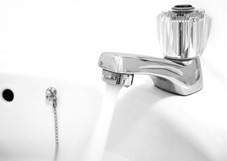Keeping Safe
Municipal Water Supply
The Source
The first stage of creating a good supply for a municipal water system is selecting the best possible source, one that will both ensure a steady supply of water and be as clean as possible.
Canadian municipalities draw water either from underground aquifers or from open bodies of water, such as reservoirs, lakes, and rivers.
In order to ensure that the source remains clean, it may be necessary to restrict access, especially to open reservoirs. Contamination from runoff is a universal concern; to protect the community's water it may be necessary to limit development, forestry, or agricultural uses in the watershed.
When water is drawn from lakes and streams, the location of the intake can be crucial, especially if sewage, industrial waste, or agricultural waste enters the same body of water.
Treatment
Municipal water is treated in a series of steps:
- Screening: The first step is the removal of large debris using screens; water that enters a treatment plant may contain debris such as weeds and fish that might clog or damage the pumps and machinery.
- Coagulation: Coagulants - chemicals that react with other substances in the water, causing them to clump together - are added next. This reaction makes removal of impurities - usually accomplished through filtration - much easier. A coagulant commonly used in modern water-treatment systems is aluminum sulfate (alum).
- Flocculation: a process that gently agitates the water to mix suspended particles, causing them to collide and form heavier particles called floc.
- Sedimentation: The flocs are moved into a settling tank, where the reduction in water velocity allows the heavier floc particles to settle to the bottom of the treatment tank. This process can remove up to 80% of suspended solids.
- Filtration: removes the particles that did not settle out in the settling tanks, as well as compounds that cause bad tastes and odours. Filtration improves the effectiveness of disinfectants (next step) by removing particles that can shelter bacteria.
- Chlorination: Chlorine is added to the water to provide disinfection. This chemical kills or inactivates most pathogens and is the most widely used disinfectant. Unfortunately, there are some down sides to the use of chlorine. Other disinfectants include iodine, ozone, ultraviolet light, and physical methods, such as boiling and steam sterilization.
Preventing Contamination After Treatment
In municipal systems, post-treatment contamination most often occurs when a water main has been broken or opened in the course of construction or repair work. Usually, all people living downstream from a spot where a main has been opened are asked to boil their water for a few days after the event, just in case their water supply has become contaminated.
Wells in Rural Areas
Wilderness Areas
Strategies for Less-Developed Areas



